
TUESDAY, JAN 17, 2023: NOTE TO FILE

Module 2-2
The Whole-Systems Approach
IN MODULE 1, we saw how a whole-system approach to restoring the hydrological cycle can combat desertification and global warming through ecosystem restoration. We have the ecological knowledge and appropriate technology to solve these issues, [so...we just lack the polical will and proper education...] to protect watersheds and provide access to water and sanitation for everyone human and non-human. This module builds on that fundamental ecological knowledge to explore the relatively simple technologies applicable to regenerative communities, focusing primarily on water systems that can be applied to the household, community or neighbourhood scale.
First, we will explore the basics of the hydrological cycle, the importance of watersheds for the major rivers in your region, and how water systems should be designed to link local needs to the integrated management of water at the bioregional watershed scale. Once we have established this context, we will take a closer look at how biological water treatment works and what systems might be appropriate at what scale and in which specific environmental context.
The Hydrological Cycle
LET’S BRIEFLY take a look at how the hydrological cycle functions and build on the basic ecological knowledge introduced in module 1. If we hope to design regenerative systems integrated into the life-supporting processes of the biosphere, we have to become nature’s apprentices first and learn to understand the ecological, climatological, and hydrological cycles on which we depend.
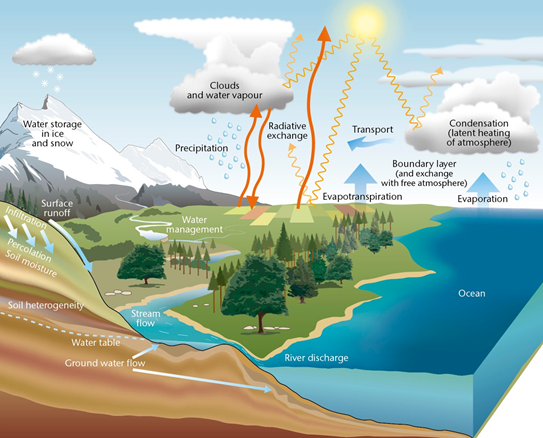
The Hydrological Cycle. Source: The Mereological Office, UK
The hydrological cycle is a closed-loop system in which water (H2O) circulates as it changes from liquid to gases (water vapour) and to solids (ice) and back to liquid. It circulates or flows between a variety of different ‘stores’ and in the process, both uses [solar energy] and produces energy [some potential energy for humans to extract from flows, but less than used to pump water, e.g. the Colorado River rarely flows to the Sea of Cortez and the Ogallala aquifer is being pumped dry]. In the stores that are reservoirs such as oceans, lakes and rivers water is a liquid. To transform into its gaseous form, through evaporation, it uses solar radiation. It is worth noting that when stored in the atmosphere as water vapour, it is a potent greenhouse gas. Overall, global heat dynamics on Earth is regulated for 75-95% by water. Restoring the hydrological cycle to store water in the ‘soil sponge’ and in underground aquifers, therefore, makes a major contribution to combating global warming and climate change [our exploitation of rainfall to increase crop production increases evapotranspiration, increasing water vapor, increasing climate change].
Terrestrial freshwater reserves are replenished when water vapour is returned to its liquid form and falls to earth as rain. To do this, it passes through a solid form as ice crystals in clouds, a process in which microbial life figures predominantly. When it falls to land where healthy, living soils and natural vegetation are waiting to receive it, rain is absorbed into the soil, used by essential soil micro-organisms and other soil life, and absorbed by plants. Any excess from heavy rainfall filters through the soil to groundwater. Land that is able to absorb and retain water is referred to as a 'water retention landscape' and we can return degraded land to this state through ecosystem restoration and regenerative agricultural practices (you will see in module 3). Urban areas can also become water retention landscapes and we will look into this in module 5.
Degraded land that has inadequate permanent vegetation cover and little soil organic matter cannot retain water and therefore rainfall returns to the oceans and lakes as runoff from the land into streams and rivers. Runoff carries with its chemical pollutants from agriculture and an excess in artificial nitrogen fertilizer. The latter feeds ‘algal blooms’ in lakes, rivers and oceans which remove oxygen for other freshwater and marine life. The result is ‘dead zones’ and toxic algae washed up onshore. Moreover, runoff from compacted land reinforces the degradation — without the infiltration of life-giving water, soil life and vegetation die, as do terrestrial species in the food webs that rely on vegetation, in an ongoing spiral of desertification. Our ecosystems are literally drying out, being drained by human activities. [Significant contraction of human footprint and enterprises/activities is to consider.]
In the hydrological cycle diagram below we can see that besides evaporation from the oceans, there is also evapo-transpiration from vegetation taking place. Transpiration occurs as plants breath, which they do through stomata covering the surface of their leaves. When they open the stomata to exhale, water that has been sucked up from the soil through the plant’s vascular system escapes into the air as water vapour.
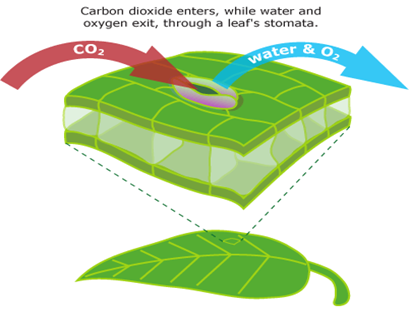
Source: evolution.berkeley.edu
This natural process produces cooling latent heat, which is one of the reasons why landscapes with vegetation are cooler. The temperature in a street lined with trees will always be a few degrees cooler than in a street where there are none. Evaporation also occurs where there is vegetation, so the combined processes are referred to as evapo-transpiration. The transpiration from forests such as the Amazon is a powerful driver of rainfall, weather and even climate.
The diagram below shows rainwater infiltration through a pervious surface. It can be drawn up through roots and returned as water vapour to the air through transpiration. Alternatively, rainwater leaves an impervious surface through runoff.
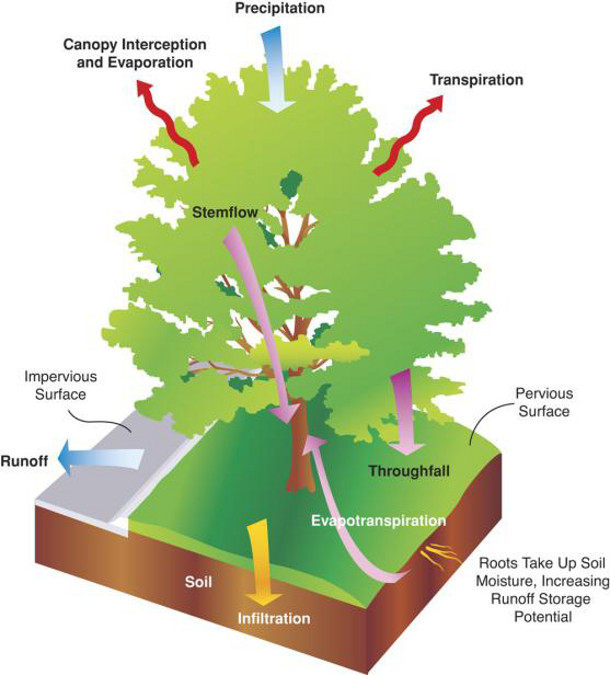
Until quite recently, physicists regarded evaporation from large bodies of water to be the main driver of the hydrological cycle, but now we know that life itself plays a major role through transpiration and ‘bioprecipitation’. New narratives, even in the sciences, often take a while to be absorbed into the mainstream, so this story starts in the early 20th century when an Austrian forest warden Viktor Schauberger [who did not include science among his talents], observed a decline in rainfall where deforestation had taken place. His insights lead to a theory, that there are ‘half’ and ‘full’ hydrological cycles, and that this plays a crucial role in rainfall. He also realised that creating impervious surfaces by removing permanent vegetation would impact on groundwater movements, the water table, soil salinity and cloud formation. Schauberger mapped out the effects of deforestation on rainfall and on surface temperatures in beautiful illustrations.
Schauberger identified the crucial role played by vegetation in maintaining the hydrological cycles as well as the maintenance of appropriate temperatures. We now know the science behind the ‘sensible’ heat rising from degraded landscapes. Schauberger also recognised the close relationship between removal of vegetation and flooding. He compared the full hydrological cycle to the passage of blood around the human body and the importance of vegetation and soil for purification and dispersal of minerals. It is an apt metaphor when we accept that the biosphere is a living, self-regulating system based on Earth Systems’ sciences to which the pioneering Schauberger had no access, such as microbiology, even though he was well aware that he was observing a natural system in perfect dynamic equilibrium.
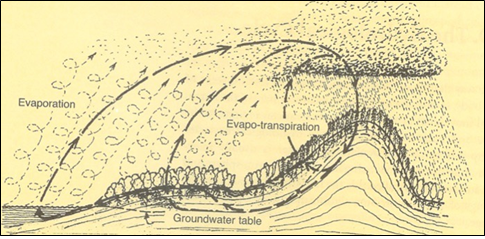
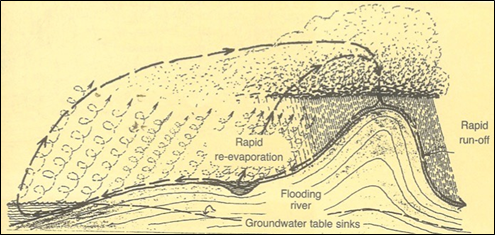
The Full and the Half Hydrological Cycles.
Source: “Hidden Nature – The Startling Insights of Viktor Schauberger”, Alick Bartholomew, 2003
Schauberger was ahead of his time and his work took a long time to gain acceptance. It is maybe a prime example that keen and dedicated observation of nature by those living and working in close proximity to it is a valuable approach to scientific inquiry. Permaculture’s first principle, ‘observe and interact’ is an excellent starting point for a whole-systems approach.
2.1. The ‘Biotic Pump’
TWO MORE RECENT developments add to our new understanding of the role played by life itself in the hydrological cycle. In 2007, a study was published by two Russian scientists, Anastassia Makarieva and Viktor Gorshkov, both nuclear physicists by training, also concerned about diminishing rainfall patterns where deforestation was taking place. Based on data from Geogia and the Caucasias where logging of old forests had been extensive, the ‘biotic pump theory’ showed that trees, pumping water into the atmosphere through transpiration, move rainfall around Continental landmasses from oceans to the interior and therefore play an essential role in weather and even regional climate. We have already encountered this addition to climatology in Dr Antonio Nobre’s talk about the invisible rivers of water vapour above the Amazon in module 1.
Makarieva and Gorshkov show that the found in natural forests (rather than monoculture tree plantations and agriculture) maintain high transpirational fluxes and suck in moisture from the oceans, the basis for at any distance from the ocean. Forests along coastlines, therefore, are also essential for a .
“Replacement of the natural forest cover by a low leaf index vegetation leads to an up to tenfold reduction in mean continental precipitation and runoff, in contrast to the previously available estimates made without accounting for the biotic moisture pump. The analyzed body of evidence testifies that the long-term stability of an intense terrestrial water cycle is unachievable without the recovery of natural, self-sustaining forests on continent-wide areas.”

Source: rain climate facebook or rainforclimate page
[The “biotic pump hypothesis,” which states that the large-scale condensation of water vapor creates horizontal pressure differences in the lower atmosphere that propel local atmospheric dynamics, is a proposed and disputed mechanism for observable phenomena. The existence of the phenomena does not prove the hypothesis.]
2.2. Bioprecipitation
WATER FREEZES in clouds at -39 C. To freeze at a lower temperature to create the ice crystals that cause rainfall requires a catalyst in the form of aerosol particles. These travel upwards on air currents and some of them are alive.
Microbial life contributes to rainfall, travelling upwards in bio-aerosols from vegetation and soil, to nucleate clouds. Bioprecipitation occurs when bacteria in clouds freeze drops of water, they have nucleated around themselves from water vapour to form ice crystals which, being heavier than water, begin to fall and subsequently melt into rain. These micro-organisms can freeze water at temperatures of -2 degrees C, whereas aerosol dust particles trigger freezing only below -15 degrees C.
Schematic representation of bioaerosols' life cycle and potential influence on atmosphere, ecosystem, and human health, modified from Pöschl (2006). Source
Bioprecipitation is an essential aspect of the hydrological cycle and deforestation is obviously having a profound effect on patterns of rainfall and drought, warming and climate change. However, many of the organisms that cause bioprecipitation, bacteria such as Pseudomonia spp and fungi such as Fusarium spp, [pathogens] are also present on agricultural land and can damage vegetation and annual crops. Some scientists have suggested that the ability to freeze water is a evolutionary adaptation that enables the micro-organisms, having been swept up into the clouds far away from their natural habitats, to return to earth and their food supply. Pseudomonia spp can access sugars from plants by freezing the stomata open. Fusarium spp are commonly found on fruit trees and cereals. Pesticides that target these organisms are effectively disrupting the bioprecipitation that is an essential aspect of the hydrological cycle and, therefore, contributing to climate change in this way.[Extraordinary claim not cited, apparently from an essay and the concern was that if crops are genetically engineered to be resistant to pesticides, use will increase and the bacteria/fungi involved in bioprecipitation will be fewer, and assuming the bioprecipitation hypothesis is correct, then that will decrease precipation. "The regulatory approval of crops genetically engineered for immunity to herbicides and pesticides may require examination through the lens of biological agent-related effects. It is currently predicted that newly engineered crops bearing pesticide immunity will increase the use of such eradicants (Pollack 2012, pp. B1, B5). This could engender severe consequences for local and regional populations of phytopathogenic biological agents, such as P. syringae. The regulatory integration of any research that may demonstrate this threat should be pursued"]
The Small Water Cycle
“…in natural ecosystems, water is integrated into small, regional water cycles, which supply vapour to the atmosphere to condense and form rain, the sun being the driving force of the circulation of water in small water cycles. We also need to appreciate the thermoregulatory processes provided by the movement of water between the surface of the earth and the atmosphere, which maintains the proper temperatures for life on earth”
Michal Kravčik and Jan Lambert, New Water Paradigm, 2007.
While the global hydrological cycle might seem dauntingly vast, so huge that as individuals and communities we can’t influence it positively, working locally to restore the small water cycle is always within our power. We can work towards rehydrating our drained ecosystems by protecting natural forests, designing and planting new ones, resisting schemes for monoculture plantations, transitioning to regenerative agriculture, recycling water back into the landscape, especially in urban areas. These local actions also contribute to achieving SDG 6 globally. To do this we need to know more about how the hydrological cycle operates in our bioregion.
Module 2, lesson 3
